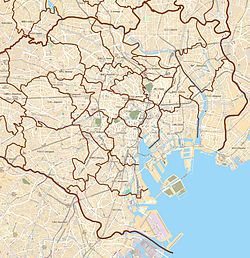Yoyogi Station
35°41′02″N 139°42′08″E / 35.683828°N 139.702320°E
JY18 JB11 E26 Yoyogi Station 代々木駅 | ||||||||||||||||||||||||||
|---|---|---|---|---|---|---|---|---|---|---|---|---|---|---|---|---|---|---|---|---|---|---|---|---|---|---|
 The main (west) entrance in July 2012 | ||||||||||||||||||||||||||
| General information | ||||||||||||||||||||||||||
| Location | 1 Yoyogi, Shibuya-ku, Tokyo Japan | |||||||||||||||||||||||||
| Operated by | ||||||||||||||||||||||||||
| Line(s) |
| |||||||||||||||||||||||||
| Other information | ||||||||||||||||||||||||||
| Station code |
| |||||||||||||||||||||||||
| History | ||||||||||||||||||||||||||
| Opened | 23 October 1906 | |||||||||||||||||||||||||
| Services | ||||||||||||||||||||||||||
| ||||||||||||||||||||||||||
| ||||||||||||||||||||||||||
Yoyogi Station (代々木駅, Yoyogi-eki) is a railway station in Shibuya, Tokyo, Japan, operated by the East Japan Railway Company (JR East) and the Tokyo Metropolitan Bureau of Transportation (Toei). It is station E-26 under Toei's numbering system.
Station layout
[edit]JR East
[edit]The JR East station consists of two ground-level side platforms on either side of an island platform, serving four tracks in total.
| 1 | JY Yamanote Line | for Shinjuku and Ikebukuro |
| 2 | JY Yamanote Line | for Shibuya and Shinagawa |
| 3 | JB Chūō-Sōbu Line | for Shinjuku, Nakano, and Mitaka |
| 4 | JB Chūō-Sōbu Line | for Ochanomizu, Akihabara, Funabashi, and Chiba |
- North gates
- Platform 1
- Platforms 2 and 3
- Platform 4
- Track layout of Yoyogi and Shinjuku stations as of 2010
Chest-high platform edge doors were installed on the Yamanote Line platforms in September 2015, and brought into use from October.[1]
There are three exits: East exit, West exit, and North exit. The latter two provide easy access to the Oedo line.
Toei
[edit]The Toei Oedo Line station has one underground island platform serving two tracks.
| 1 | E Ōedo Line | for Roppongi |
| 2 | E Ōedo Line | for Hikarigaoka |
- Toei platforms, December 2019
- Ticket gates, October 2020
History
[edit]The station first opened on 23 October 1906 by a private company as a station on the Chūō Main Line, but was nationalized only a week later when the Japanese National Railways (JNR) took over the company and all of its assessments. The underground Toei Ōedo Line station opened on 20 April 2000.[2]
Station numbering was introduced to the JR East platforms in 2016 with Yoyogi being assigned station numbers JB11 for the Chūō-Sobu line, and JY18 for the Yamanote line.[3][4]
Passenger statistics
[edit]In fiscal 2013, the JR East station was used by an average of 70,016 passengers daily (boarding passengers only), making it the 63rd-busiest station operated by JR East.[5] In fiscal 2013, the Toei station was used by an average of 17,382 passengers daily (boarding passengers only).[6] The daily average passenger figures (boarding passengers only) for JR East in previous years are as shown below.
| Fiscal year | Daily average |
|---|---|
| 2000 | 55,062[7] |
| 2005 | 68,471[8] |
| 2010 | 69,704[9] |
| 2011 | 69,466[10] |
| 2012 | 70,418[11] |
| 2013 | 70,016[5] |
See also
[edit]References
[edit]- ^ 山手線代々木駅に可動式ホーム柵が設置される [Platform edge doors installed on Yoyogi Station Yamanote Line platforms]. Japan Railfan Magazine Online (in Japanese). Japan: Koyusha Co., Ltd. 26 September 2015. Retrieved 27 September 2015.
- ^ Terada, Hirokazu (July 2002). データブック日本の私鉄 [Databook: Japan's Private Railways]. Japan: Neko Publishing. ISBN 4-87366-874-3.
- ^ "⾸都圏エリアへ 「駅ナンバリング」を導⼊します" [Introduce “station numbering” to the Tokyo metropolitan area] (PDF). jreast.co.jp (in Japanese). 6 April 2016. Archived from the original (PDF) on 7 December 2022. Retrieved 7 January 2023.
- ^ Kusamachi, Yoshikazu (7 April 2016). "JA・JK・JT・AKB…JR東日本、首都圏で駅ナンバリングなど導入へ" [JA, JK, JT, AKB … JR East to introduce station numbering in the Tokyo metropolitan area]. Response Automotive Media (in Japanese). Archived from the original on 6 August 2022. Retrieved 7 January 2023.
- ^ a b 各駅の乗車人員 (2013年度) [Station passenger figures (Fiscal 2013)] (in Japanese). Japan: East Japan Railway Company. Retrieved 24 January 2015.
- ^ 各駅乗降人員一覧 [Station usage figures] (in Japanese). Tokyo Metropolitan Bureau of Transportation. Retrieved 24 January 2015.
- ^ 各駅の乗車人員 (2000年度) [Station passenger figures (Fiscal 2000)] (in Japanese). Japan: East Japan Railway Company. Retrieved 24 January 2015.
- ^ 各駅の乗車人員 (2005年度) [Station passenger figures (Fiscal 2005)] (in Japanese). Japan: East Japan Railway Company. Retrieved 24 January 2015.
- ^ 各駅の乗車人員 (2010年度) [Station passenger figures (Fiscal 2010)] (in Japanese). Japan: East Japan Railway Company. Retrieved 24 January 2015.
- ^ 各駅の乗車人員 (2011年度) [Station passenger figures (Fiscal 2011)] (in Japanese). Japan: East Japan Railway Company. Retrieved 24 January 2015.
- ^ 各駅の乗車人員 (2012年度) [Station passenger figures (Fiscal 2012)] (in Japanese). Japan: East Japan Railway Company. Retrieved 24 January 2015.
External links
[edit]- JR East station information (in Japanese)
- Toei station information (in Japanese)


 French
French Deutsch
Deutsch








